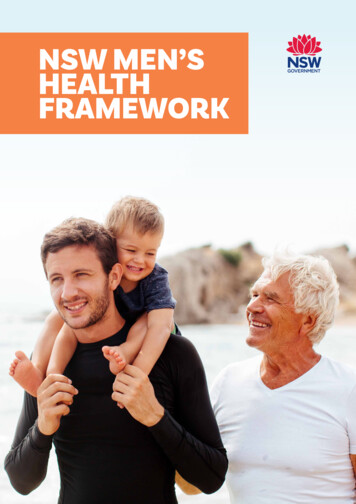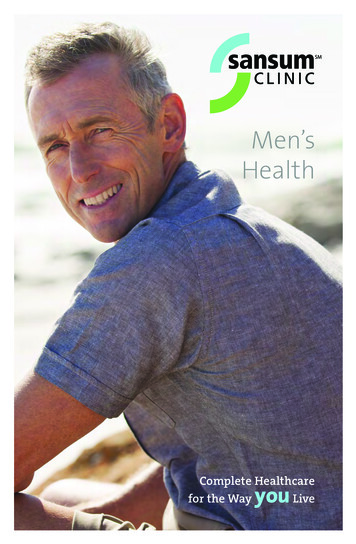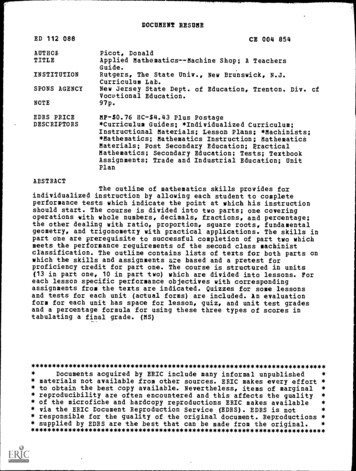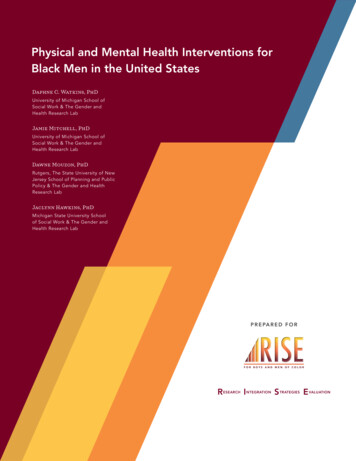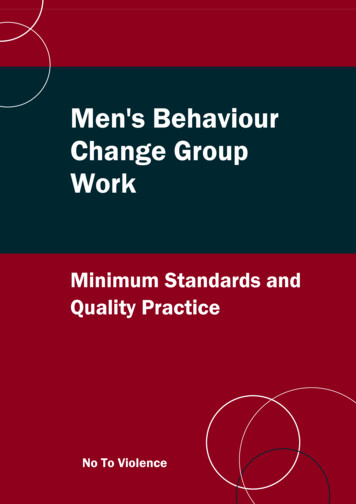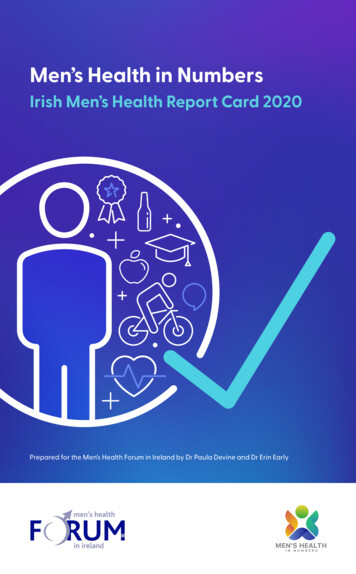
Transcription
lthMen’s Health in NumbersIrish Men’s Health Report Card 2020Prepared for the Men’s Health Forum in Ireland by Dr Paula Devine and Dr Erin EarlyMEN’S HEALTHINNU MBERS
THANKS AND ACKNOWLEDGEMENTSThe production of this report was only possible becauseof the generosity, goodwill, support, advice and practicalassistance offered by a broad range of individuals andorganisations.The Men’s Health Forum in Ireland (MHFI) would like to give special mention to: Health Service Executive (HSE) Health and Wellbeing – for providing thefunding to undertake this data gathering process. The research team / report authors – Dr Paula Devine and Dr Erin Early fromARK (www.ark.ac.uk) within Queen’s University Belfast (QUB). Prof Derek Griffith, from Vanderbilt University, USA, who generously shared hisexperience of developing the Tennessee Men’s Health Report Card with us.This was the inspiration behind our Men’s Health in Numbers publications. All of the people who contributed to the Advisory Group for this initiative:· Prof Kevin Balanda: (ex-) Institute of Public Health in Ireland· Colin Fowler: Men’s Health Forum in Ireland· Fergal Fox: HSE Health and Wellbeing· Dr Karen Galway: School of Nursing and Midwifery, QUB· Finian Murray: HSE Health and Wellbeing· Shane O’Donnell: Marie-Curie Early Stage Researcher· Biddy O’Neill: Department of Health, Republic of Ireland· Dr Gillian Prue: School of Nursing and Midwifery, QUB· Dr Noel Richardson: National Centre for Men’s Health, IT CarlowRUMmen's healthMEN’S HEALTHI NN U M B E R SARKin irelandCITATIONDevine, P. and Early, E. (2020), Men’s Health in Numbers: Irish Men’s Health Report Card 2020.Dublin: Men’s Health Forum in Ireland.This report is available online at: www.mhfi.org/MensHealthInNumbers2.pdf2
IntroductionThe Men’s Health Forum in Ireland (MHFI) is a diverse network of individualsand organisations, men and women, from both the Republic of Ireland andNorthern Ireland. The Forum was established in 1999, and operates on anall-island basis.MHFI was established in response to the growing recognition of the need to address the poor healthstatus of males in Ireland. However, one of the first challenges facing it was to gain access to reliabledata upon which to plan future interventions. This remains an ongoing concern - as the Forum seeks towork in an evidence informed way.This barrier was, initially, overcome when MHFI launched its seminal Men’s Health in Ireland report inJanuary 2004 (www.mhfi.org/fullreport.pdf). This document provided the most comprehensive overviewof key statistics on men’s health on the island of Ireland ever collated up to that time. It offered clearevidence of local males’ health needs, and a roadmap for action. Importantly, it also provided a baselineagainst which to measure progress in the future.To mark its twenty-first birthday in 2020, the Forum undertook an initiative titled Men’s Health in Numbers.Funded by the Health Service Executive (HSE) Health and Wellbeing, this sought to produce:1. A comprehensive Trends Report that describes changes in significant markers of men’s health on theisland of Ireland between 2004 and 2019.2. An Irish Men’s Health Report Card (this document) that provides a contemporary synopsis of key men’shealth statistics in the Republic of Ireland.The amount of data available on the health of men and boys in Ireland is almost endless. This Report Cardcan only give a flavour of some of the important issues in the lives of local males. It focuses upon headlinestatistics and, for simplicity, presents most of these as infographics. If you would like to explore moredetailed data, please have a look at the substantive Men’s Health in Numbers: Trends on the Island ofIreland report which is available at: www.mhfi.org/MensHealthInNumbers1.pdf Alternatively, check-outsome of the data sources on page 19 of this Report Card.A lot has changed in Ireland - and the world - since our Men’s Health in Ireland report was published in2004. Indeed, even at the deadline for publication of this Report Card, the range of data available to usis constantly evolving and changing. COVID-19 is also having a dramatic impact upon the health andwellbeing of everyone in Ireland and, no doubt, will have a long-lasting legacy. Thus, this Report Cardonly represents a snapshot taken at one particular period in time.The figures in this booklet provide some cause for optimism, alongwith some grounds for concern. The four main causes of deathamong males in Ireland continue to be neoplasms, circulatorysystem diseases, respiratory system diseases, and external causesof injury and poisoning. That said, it is important to note that deathrates from these have often been reduced due to factors such asthe adoption of healthier lifestyles, the uptake of screeningprogrammes, better diagnostic tools, improvements in healthliteracy and help-seeking behaviours, availability of supportservices, and more effective treatment options.The figures in thisbooklet providesome cause foroptimism, alongwith some groundsfor concern.3
This progress, combined with the fact that Irish males now live longer, means that the overall populationof males in Ireland is ageing. The downside, though, is that we can expect a higher incidence of somecancers and chronic conditions in the future.Ireland has the highest rate of diagnosed prostate cancer in the EU. The incidence rate for nonmelanoma skin cancer (NMSC) has doubled since 1994. Excessive alcohol use remains high. Too manymales are overweight. The number of males diagnosed with gonorrhoea and HIV has increased However, the mortality rate for all invasive cancers (excluding NMSC) has fallen and the survival rate hasincreased. There are fewer male smokers. The number of male suicides has fallen. The proportion ofmale deaths due to diseases of the circulatory system has decreased But Irish males are not a homogenous group, and there are significant differences in the circumstances oftheir lives, health behaviours and health outcomes. Indeed, it is worrying that incidence rates of diseasesand chronic conditions are, mostly, higher within areas of deprivation.It is worrying thatincidence ratesof diseases andchronic conditionsare, mostly, higherwithin areas ofdeprivation.Not too long ago, we were unaware of the full extent of men’s poorhealth status and the specific health issues that they are contendingwith. However, this is no longer the case. In recent years, a broad range ofresearch has highlighted the health challenges which face men in Irelandand further afield. Yet, although the health of local men can, sometimes,be poor, it is not a ‘lost cause’. It can be improved in many significant ways.Indeed, a wide range of innovative and pioneering initiatives have alreadybeen developed to support the health needs of men and boys. Someexamples of these are peppered throughout this Report Card.Much has already been achieved but, as they often say in Report Cards:‘there is still room for improvement’. Males, themselves, need to play acentral role in taking control of their health and wellbeing. However, malehealth is not just an issue for individual men and boys; their health can oftenbe determined and influenced by other policy, economic, environmental,educational and social factors which are outside of their personal control.This dynamic is represented in the ‘Health Impact Pyramid’ towards theend of this booklet on page 18. Thus, there is also a role in improving malehealth for decision-makers, service providers and society as a whole.The Republic ofIreland was the firstcountry in the worldto adopt a NationalMen’s Health Policyand, subsequently,a Men’s HealthAction Plan.Male health is not justan issue for individualmen and boys. It canbe determined andinfluenced by factorswhich are outside oftheir personal control.The Republic of Ireland was the first country in the world to adopt aNational Men’s Health Policy and, subsequently, a Healthy Ireland - MenAction Plan. Ireland was, and still is, an international leader in this field.We hope that our Men’s Health in Numbers publications will add to thisreputation. More importantly, we hope that these materials will be apractical resource for many organisations across Ireland - by highlightingsome of the main areas for concern, providing evidence of need, mappingthe magnitude of the work which needs to be undertaken, and inspiringpractical and realistic responses.The Men’s Health Forum in Ireland4
PopulationTOTAL POPULATIONAREA OF RESIDENCE(2020)POPULATION OF IRELANDIN 2020: 4,977,433MALES: 2,465,571 (49.5%)49.5%50.5%Source: CSO Statbank Table PEA04AGE PROFILEMALES HAVE AYOUNGER AGE PROFILETHAN FEMALESAGE 8.4%65-744.2%4.8%75-841.2% 85 2%Source: based on CSO Statbank PEA01AGEINGAGE70 AGE80 000s% of on2020: 9.2% (227,762)2051: 18.8% (561,807)2020: 2.9% (70,330)Source: CSO Statbank Table PEA042051: 8.2% (244,297)CASE STUDYAGE90 2020: 0.4% (9,964)2051: 1.8% (53,739)THE NUMBER OF OLDERMEN IS EXPECTED TO RISEOVER THE NEXT 30 YEARSSource: based on CSO Statbank PEA11, PEA22GAA Healthy Club ProjectThe GAA Healthy Club Project supports local clubs toexplore how they can best support the holistic healthof their members, and the communities that they serve,by: reflecting upon what they are already doing well;identifying areas where they would like to improve;and empowering them to ensure that everyone whoengages with their club - in whatever capacity benefits from the experience in a health-enhancing -club5
LIFE EXPECTANCYLife Expectancy at BirthLIFE EXPECTANCYAT BIRTH FOR MALESHAS INCREASEDOVER TIME200720182016 Life Expectancy atBirth by Area of LE EU-2877.3MALE82.1FEMALE80.5MALE84.1FEMALESource: Eurostat Table TPS0020879.483.2FEMALE84.4BUT THOSE IN THEMOST DEPRIVED AREASHAVE SHORTER LIVES87.7FEMALESource: CSO Mortality Differentials in Ireland 2016-2017Healthy Life ExpectancyHEALTHY LIFEEXPECTANCYFOR MALES HASINCREASED20072018MALEFEMALEMALEFEMALE EU-2862.965.668.470.4Source: Eurostat Table hlth 69.7%2020:of males (311,580)had a disabilityin 2016males were recordedas homeless in 2016of the homelessmales were in Dublin(2,802 men)41,900 male emigrants36,800 male immigrants27,900 male emigrants41,900 male immigrantsSource: CSO Statbank Table PEA16, PEA17Source: CSO Statbank Table E5001Source: CSO Statbank Table EZ0426THE NUMBER OF MALES LEAVING IRELAND HASDECREASED, WHILE THE NUMBER OF MALESCOMING TO IRELAND HAS INCREASED
Family andRelationshipsMARITAL STATUS (2016)Number%Married (first ied34,5831.9%Registered same-sex civil partnership2,5260.1%Source: CSO Statbank Table EZ004LONE FATHERS23,800males were lone parentsin 2018CARINGRESPONSIBILITIESIn 2016:77,112males provided unpaidcare. This represents39% of people providingunpaid care.1,875Source: CSO Women and Menin Ireland 2019, Table 4.3CASE STUDYEngageThe Engage National Men’s Health Training Programmewas developed to assist practitioners to build effectiverelationships with males of all ages in order to addresstheir health and wellbeing needs. Engage offers serviceproviders a range of focused one day experiential andinteractive workshops, that increase their understandingof the world of men, and help them to develop strategiesfor making realistic connections.https://engagetraining.iemales aged 0-14provided unpaid care26%of male carers provided29 hours or more ofunpaid care each weekSource: CSO Women and Men in Ireland 2019, Table 2.147
Educationand WorkEDUCATIONAL EXPERIENCESCHOOL ATTENDANCETHIRD LEVEL QUALIFICATIONFemales attended schoolfor longer than malesMALE31.6%FEMALE40.7%43.2%(2016)of males in 2016 had not attended schoolbeyond lower secondary, comparedwith 26.2% of females(2016)Source: CSO Census of Population 2016 - Profile 10 Education, Skills and the Irish LanguageTHERE HAS BEENA FALL IN THEPROPORTION OFYOUNG MALESWHO ARE NOT INEMPLOYMENT,EDUCATIONOR TRAININGYOUNG MALES WHO ARE NOT IN EMPLOYMENT,EDUCATION OR TRAINING (NEET): % OF 18-24 YR OLDS2008201817.7%REPUBLIC OF IRELANDEU2812.3%REPUBLIC OF IRELAND12.5%EU2813.1%Source: CSO Women and Men in Ireland 2019, Table 3.1&EARNINGS (FULL-TIMEPART-TIME)MEDIAN ANNUAL INCOME(AGED 15 ) 2018: 39,658 32,264This means that half of all males earnedbelow 39,658 and half earned above 39,658Source: CSOStatbank Table NSA818HOURS WORKED52.8% 24.7%of malesworked at least40 hours aweek in 2018of femalesworked at least40 hours aweek in 2018Source: CSO Women and Men in Ireland 2019, Table 5.8CASE STUDYSheds for LifeSheds for Life is a community-based health promotionprogramme aimed at supporting local members of IrishMen's Sheds. The programme seeks to facilitate open andmeaningful health-focused discussions, while encouragingmen to adopt and maintain healthier lifestyle choices, andto increase their awareness in areas such as physical activity,healthy eating and mental wellbeing.https://menssheds.ie/sheds-for-life
EMPLOYMENT RATES2009:15.6%THETHE MALEMALEUNEMPLOYMENTUNEMPLOYMENTRATERATE HASHAS FALLENFALLENSINCESINCE 20092009TheThe COVIDCOVID pandemicpandemic hashas hadhad aa hugehugeimpactontheeconomy.Thismeansimpact on the economy. This means thatthatfuturefuture employmentemployment andand unemploymentunemploymentfiguresfigures will,will, mostmost likely,likely, bebe veryvery different.different.2019:5.6%HOWEVER,HOWEVER, ITIT ISIS LIKELYLIKELYTHATTHAT COVIDCOVID WILLWILL HAVEHAVE AAHUGEHUGE IMPACTIMPACT ONON MALEMALEEMPLOYMENTEMPLOYMENTMALEMALE EMPLOYMENTEMPLOYMENT RATERATE(%(% OFOF 15-6415-64 AGEAGE GROUP)GROUP)2009200920192019REPUBLICREPUBLIC OFOF REPUBLIC OFOF nd20192019OCCUPATION GROUPS%Number% ofof workersworkersNumber ofofmaleswho areare malemalemales (000s)(000s) who20182018SkilledSkilled tradestrades288.3288.390.990.9Process,Process, plantplant andand machinemachine agers, directorsdirectors andand seniorsenior officialsofficials119.4119.465.565.5OtherOther // notnot statedstated5.95.959.059.0AssociateAssociate professionalprofessional andand entary (mostly(mostly sProfessionals224.4224.446.646.6SalesSales andand customercustomer strative andand g, leisureleisure andand otherother inIrelandIreland2019,2019,TableTable5.65.6RISK OFPOVERTY14.7%ofof malesmales werewere atatriskofpovertyrisk of poverty(after(after socialsocialtransferstransfers andandpensions)pensions) inin 20172017 andIreland2019,2019,TableTable6.16.19
Healthand LifestyleGENERAL MEDICALSERVICES SCHEMESELF-REPORTEDHEALTH30%In 2019:of males had amedical card in 2018Source: CSO Women and Men in Ireland 2019, Table 2.7GP VISITSAverage number of GP visitsin previous 12 months (2019)Source: Healthy Ireland 2019Males aged 15 : 3.5 visitsMales aged 15-24: 2.6 visitsMales aged 75 : 9.7 visitsWEIGHTIn 2019:Source: Healthy Ireland 2019Achieving National PhysicalActivity Guidelines (2019)All Males 15 71%Males 45-54Males 75 42% of males were overweight24% of males were obeseSource: Healthy Ireland 201954%Males 15-2453%20%SUN PROTECTION89% of males report using a formof sun protection when in the sunfor more than 30 minutes at a timeSource: Healthy Ireland 2019PROBLEM DRUG USESource: Healthy Ireland 20197,626 males were treated forproblem drug use (2018)ALCOHOLSource: Health Research Board, National DrugTreatment Reporting System 2012-2018 Drug DataIn 2018:SMOKING% of males who smoke THE NUMBER OF2007:31%2019:19%Source: Healthy Ireland 20191085% of males rated theirhealth as good or very good94% of males aged 15-24 ratedtheir health as good or very good60% of males aged 75 rated theirhealth as good or very goodMALE SMOKERSHAS FALLENSINCE 200778% of men haddrunk alcoholduring the previous12 months54% of men who drank alcoholreported that they binge drink(six or more standard drinks) ona typical drinking occasionSource: Healthy Ireland 2018
Causeof DeathCANCER IS NOW THE LEADING CAUSE OF DEATH FOR MALESLEADING CAUSES OF DEATHFOR MEN IN IRELAND (2019)5.7%LEADING CAUSES OF DEATHFOR 0-14 YEAR OLD ses of thecirculatory systemTOTALDEATHS9.1%Diseases of therespiratory system31.8%Congenital malformationsand chromosomal abnormalitiesNeoplasms154External causes ofinjury and poisoning29.2%Certain conditions originatingin the perinatal period5.8%Symptoms, signs, abnormalfindings, ill-defined causeDiseases of the nervoussystem31.8%EXTERNAL CAUSES OF INJURY AND POISIONING (INCLUDING ACCIDENTS,SUICIDE AND INTENTIONAL SELF-HARM) IS THE LEADING CAUSE OF DEATHFOR 15-34 YEAR OLD MALESLEADING CAUSES OF DEATHFOR 15-34 YEAR OLD MALES2.5%7.3%8%12.4%LEADING CAUSES OF DEATHFOR 35-54 YEAR OLD MALESExternal causes of injuryand poisoning (includingaccidents, suicide andintentional OTALDEATHSDiseases of thenervous system61.5%Diseases of thecirculatory systemNeoplasms23.7%Diseases of the circulatory system1,244Ischaemic heart disease26.2%8.8%TOTALDEATHS5,208LEADING CAUSES OF DEATHFOR 75 YEAR OLD MALESNeoplasms4.1%4.1%4.6%3.1%5.5%Diseases of thecirculatory system44.5%27.9%14.2%Diseases of therespiratory systemExternal causes of injuryand poisoningDiseases of thedigestive systemDiseases of the digestive systemDiseases of the nervous systemEndocrine, nutritionaland metabolic diseasesLEADING CAUSES OF DEATHFOR 55-74 YEAR OLD MALESExternal causes of injury andpoisoning (including accidents,suicide and intentional self-harm)Diseases of the circulatory systemNeoplasmsTOTALDEATHS9,34831.8%Diseases of the respiratory systemDiseases of the nervous systemDiseases of the digestive system28.6%Diseases of thenervous systemSource: CSO Vital Statistics seriesDISEASES OF THE CIRCULATORY SYSTEM IS THELEADING CAUSE OF DEATH FOR MALES AGED 75 11
10 YEAR TRENDS: LEADING CAUSES OF MALE DEATH% OF ALL MALE s of thecirculatory system15%10%12.08.45.75%0Diseases of therespiratory system11.3External causes ofinjury and poisoning20092019CASE STUDYFarmers Have Hearts Cardiovascular Health ProgrammeThe Farmers Have Hearts Cardiovascular Health Programme is a health intervention which targets male Irish farmers.The programme consists of a baseline health check, a health behaviour change intervention, and a repeat health checkat 52 weeks. The overall goal of this on-going programme is to assess its effectiveness in terms of farmers’ follow-up useof health services, sustainable health behaviour change, and reduced CVD -hearts-cardiovascular-health-programme.phpROAD FATALITIES111male roadfatalities in 2019Source: CSO Women and Men in Ireland 2019, Table 1.7SUICIDEOVERALL,THE NUMBER OFMALE SUICIDESIS FALLINGMALE DEATHS BY SUICIDE2012: 4722017: 3102018: 327Highest rate was among45-54 year olds (32.3 per 100,000)Highest rate was among25-34 year olds (20.3 per 100,000)Highest rate was among55-64 year olds (23.8 per 100,000)Source: National Office for Suicide Prevention, Briefing on CSO Suicide Figures, 4 November 2020CASE STUDY‘Challenges and Choices’ Man ManualThe ‘Challenges and Choices’ Man Manual is a free booklet which highlights ten keymen’s health issues. It then: issues a realistic and practical challenge to improve thereader’s health in each area of concern; provides a reason for why it is important toconsider taking action; offers three possible choices for what actions can be taken;signposts the reader to local sources of help and support.www.mhfi.org/challenges2020.pdf12
MAJOR TRENDS:PROPORTION OF MALE DEATHS 2009-2019WORSENeoplasms (C00-D48)Mental and behavioural disorders (F00-F99)Diseases of the nervous system (G00-G99)Cancer of the rectum and anusCancer of the liverSAMEInfectious and parasitic diseases (A00-B99)Diseases of the blood and blood-forming organs, immunological disorders (D50-D89)Endocrine, nutritional and metabolic diseases (E00-E90)Diseases of the digestive system (K00-K93)Diseases of the skin and subcutaneous tissue (L00-L99)Diseases of the musculoskeletal system / connective tissue (M00-M99)Diseases of the genitourinary system (N00-N99)Certain conditions originating in the perinatal period (P00-P96)Congenital malformations and chromosomal abnormalities (Q00-Q99)Symptoms, signs, abnormal findings, ill-defined causes (R00-R99)Diseases of the eye and adnexa (H00-H59)Diseases of the ear and mastoid process (H60-H95)Cancer of oesophagusCancer of the pancreasCancer of the larynx, trachea, bronchus, lungCancer of the skinProstate cancerHomicide / assaultEvents of undetermined intentBETTERDiseases of the circulatory system (I00-I99)Diseases of the respiratory system (J00-J99)External causes of injury and poisoning (V01-Y89)Cancer of the stomachCancer of the colonIschaemic heart diseaseAcute myocardial infarctionCerebrovascular diseasePneumoniaChronic lower respiratory diseaseAccidentsTransport accidentsAccidental poisoningSuicide and intentional self-harm13
Malesand Cancer1Cancer is thenumber onecause of maledeath in IrelandIRELAND HAS THE HIGHESTRATE OF DIAGNOSES OFPROSTATE CANCER IN THE EUCANCER RISKIn 2017/19, the risk of being diagnosed with:1 in 3Any invasive cancer (excludingnon-melanoma skin cancer)1 in 6Non-melanoma skin cancer1 in 8Prostate cancer1 in 21Colorectal cancer1 in 23Lung cancer1 in 62Melanoma1 in 70Non-Hodgkin Lymphona1 in 74Kidney cancer1 in 139Bladder cancer1 in 148Liver cancer1 in 183Testicular cancer1 in 1,196 Breast cancerCASE STUDYIreland: World Leader in Male HealthThe Republic of Ireland was the first country in the world toadopt a National Men’s Health Policy. This policy highlightedthe broad range of health and wellbeing issues facing men,and outlined frameworks and strategies to address theseneeds. In 2017, this Policy was succeeded by the ‘HealthyIreland - Men’ Action Plan. This cemented Ireland’s reputationas a world-leader in addressing male health needs.www.mhfi.org/menshealthpolicy.pdf www.mhfi.org/HI-M.pdf14HOWEVER, THIS MAY REFLECTTHE USE OF PSA SCREENINGCASE STUDYMen’s Health WeekInternational Men’s Health Week - held in Juneeach year - offers an annual opportunity to:heighten awareness of preventable healthproblems for males of all ages; support men andboys to engage in healthier lifestyle choices /activities; and encourage the early detection andtreatment of health difficulties in males. In 2020,90 organisations across the island of Irelandcontributed to the Planning Group for the week.www.mhfi.org/mhw/about-mhw.htmlCancer isthe cause of33.1%of all male deathsCANCER DEATHSNumber of Cancer Deaths (2019)Neoplasms5,390Larynx and trachea /bronchus / lung1,183Prostate621Lymph /haematopoietic tissue491Pancreas298Oesophagus268
AGE STANDARDISED DEATH RATESAllneoplasmsCancer oftrachea,bronchusand ecancer275.96IRELANDIRELANDEU285.18THE AGE STANDARDISEDDEATH RATES IN IRELANDFOR THESE ARE HIGHERTHAN THE EU-28 AVERAGE3.24IRELANDEU2816.6214.85THE MORTALITY RATE FORALL INVASIVE CANCERS(EXCLUDING NMSC) HASFALLEN AND THE SURVIVALRATE HAS INCREASEDSURVIVAL RATESAge Standardised 5 Year Net Survival(all invasive cancers, excluding NMSC)1994-1999: 39%2011-2015: 63%Source: National Cancer Registry IrelandPROSTATE CANCER29%Average annual figures (2017-2019)of all : National Cancer Registry IrelandTESTICULAR CANCERTESTICULAR CANCER ISTHE MOST COMMONLYDIAGNOSED CANCER AMONGMALES AGED UNDER 45Average annual figures (2017-2019)risk:1801 in 183diagnosesTHE MORTALITY RATEFOR TESTICULAR CANCERIS LOW, AND THE SURVIVALRATE HAS INCREASEDSKIN CANCERTHE INCIDENCE RATEFOR NON-MELANOMASKIN CANCER HASDOUBLED SINCE 1994Non-Melanoma Skin Cancer (NMSC)1994:2,826diagnoses2017-2019:6,621diagnoses per yearHOWEVER, THE MORTALITYRATE FOR NMSC IS LOWSource: National Cancer Registry Ireland15
15.7%15.7%ofofdeathsdeathsofofmalesmalesagedaged75 75 6:IRELANDIRELANDEU28EU28200.08200.08161.76161.76
RESPIRATORY DISEASESCASE STUDYMen on the MoveMen on the Move is a free, twelve week, communitybased beginners’ physical activity programme forinactive adult men. It is delivered by Local SportPartnerships in conjunction with the HSE and SportIreland, and creates an environment within whichparticipants can connect with their surroundings andother men. It consists of structured group exercise,experiential workshops, resources and a finalcelebration event.www.sportireland.ie/YPB/MOMTHE MALE DEATH RATEFOR RESPIRATORYDISEASES IS HIGHERTHAN THE EU AVERAGETHE MALE DEATH RATEFOR RESPIRATORY DISEASESHAS FALLEN IN IRELANDIn 2019, respiratory diseases accounted for:11.3%of maledeaths(1,835)8.8%of deaths of55-74 yearold males14.2%of deathsof malesaged 75 Standardiseddeath rate 2016:IRELANDEU28164.66115.54Source: CSO Vital Statistics seriesSEXUALLY TRANSMITTED INFECTIONSTHE NUMBER OF MALESDIAGNOSED WITHGONORRHOEA HAS INCREASEDMales diagnosed with gonorrhoea2010: 4782018: 709Source: Health Protection Surveillance CentreTHE NUMBER OF MALESDIAGNOSED WITH HIVHAS INCREASEDCASE STUDYMale Mental Health ResearchThe Men’s Health Forum in Ireland (MHFI) coordinated twomajor pieces of action research into male mental health andsuicide. The first of these targeted young adult men, and thesecond middle-aged men. Both sought to: establish theevidence base; explore key risk factors; identify models ofeffective practice; and implement strategies to improve themental health and wellbeing of at risk and vulnerable groupswithin these age MAMRMreport.pdfMales diagnosed with HIV2009: 2582018: 411Source: Health Protection Surveillance Centre17
Health ImpactPyramidIMPROVING THE HEALTH OF MEN AND BOYSImproving the health and wellbeing of men and boys in Ireland requires action at a number of differentlevels. Ireland was the first country in the world to adopt a National Men’s Health Policy. This, and itssuccessor, the Healthy Ireland Men Action Plan, offer a road map and framework for future development.Supportindividuallifestyle andhealth behaviourchangeSupport men to eat morehealthily, engage in regularphysical activity, reduce risktaking, stop smoking, drink less,drive carefully, stay connectedto others, reduce salt intake, seekhelp early MOST INDIVIDUAL INPUTLOWEST IMPACTThe diagram below describes some of the intervention levels and actions that need to be achieved. Itdraws upon the concept of a ‘Health Impact Pyramid’ which was proposed by Thomas Frieden [Frieden,T.R. (2010). A Framework for Public Health Action: The Health Impact Pyramid. American Journal of PublicHealth, 100(4), 590-595]Improve access to health andwellbeing services and supportsMake all services affordable, gender sensitive,easily accessible, relevant, appropriate, responsiveto needs, male-friendly HIGHEST IMPACTFocus upon prevention and health promotion, offer screeningprogrammes, support community-based health initiatives, ensure healthand safety at work, create more green spaces, regulate food products,encourage neighbourhood watch schemes, establish smoke-free publicspaces, develop walking trails, enforce speeding rules, offer opportunitiesfor collective action and building relationships Address economic, structural and systemic factors that affect men’s healthImprove access to meaningful employment, a ‘living wage’, quality healthcare,affordable housing, educational advancement, nutritional food, clean water,effective sanitation, crime-free communities 18LEAST INDIVIDUAL INPUTCreate healthier societal / community / environmentalcontexts where men live, work and play
ResourcesUSEFUL SOURCES OF DATAAND FURTHER INFORMATIONIf you would like to find out more about the world of men and boys in Ireland, you can visit:Central Statistics Officewww.cso.ieCentral Statistics Office, Women and Men in Ireland 2
1. A comprehensive Trends Report that describes changes in significant markers of men’s health on the island of Ireland between 2004 and 2019. 2. An Irish Men’s Health Report Card (this document) that provides a contemporary synopsis of key

